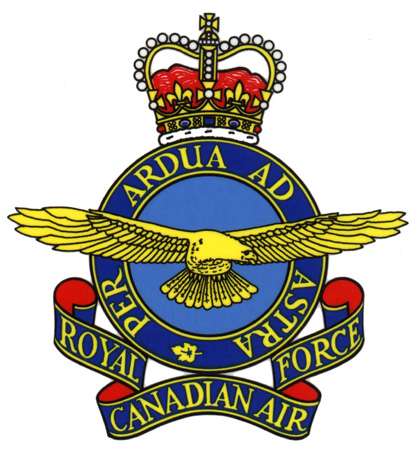 |
|
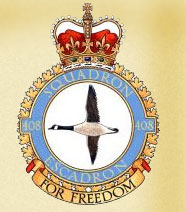 |
George Henry Scott
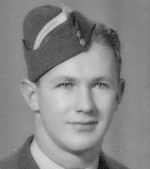
Flight Sergeant
408 Squadron
Royal Canadian Air Force
who died in action
27 January 1944, age 22
(Photo Note: This photo of Buster was taken early in his training, perhaps when he first became an aircrew trainee (as shown by the white 'flash'
in his hat. This photograph was first obtained by me from Howard Scotter)
Background to the most recent updates (revised 27 January 2021)
Just over a year ago I was visited by Scott Taylor, George's nephew. Scott is the first person in that part of the family with whom I have had contact. From him I learned much about the portion of the family that descended from John Thomas Scott (b. 1857) who was George's father. In particular I learned that (just as earlier indicated in a photo provided by Howard Scotter -- see below for more information on Howard) was known as "Buster". In this revision I adjust the name reference in many instances to the name Buster.I also learned, from Scott, more details about Buster's family as well as some information on the descendants of John Thomas. This information is included in this revision and I hope someday to make contact with those family members.
The Memorials
Buster is buried at the Hanover Commonwealth War Graves Cemetery located outside Hannover, Germany. These photographs of the grave and cemetery are from a visit I made there on 17 September 2015. At the cemetery George is buried with the other members of the crew he was flying with, all of whom were killed during the crash of their Lancaster bomber EQ-X during the night of January 27 - 28, 1944.| Cemetery
Identification Panel |
Central aisle of the Cemetery, with
memorial cross in the background |
The row of crosses in which are the
crew of EQ-X |
| Buster's headstone |
The inscription chosen by the
family (his mother, Joan, or perhaps his
step-mother Barbara who raised him or perhaps his
sisters) for the headstone |
My record: kneeling beside Buster's
headstone. I am wearing the RCAF tie with the RCAF
lapel pin. |
Buster is commemorated in the Book of Remembrance in the Peace Tower in Ottawa on page 439 of the Second World War book.
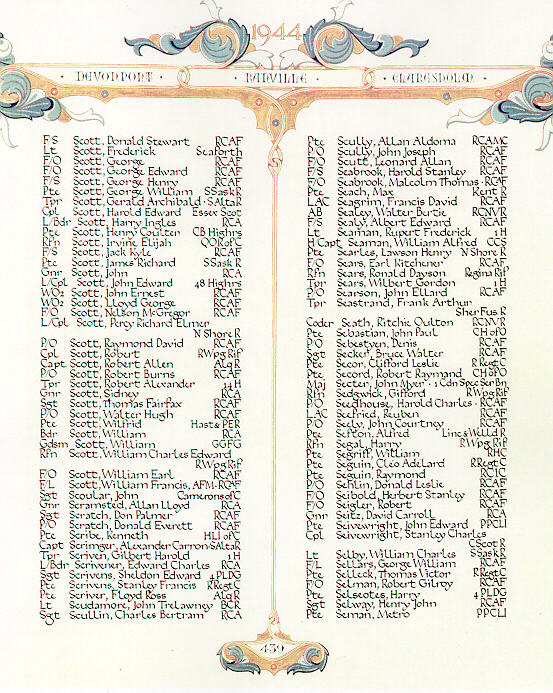 |
|
The Memorial Roll in the Peace Tower in the House of Commons in Ottawa This roll lists
all of the war fatalities of the Canadian
Forces and the page shown above includes the
name of F/S George Henry Scott.
|
 |
|||
| On the
left is the memorial central panel. Next right
is a photograph of the memorial wall and to the
right of that the panel that includes Buster's
name. On the right of that is the Lancaster
Bomber that has been restored for taxiing
purposes with all engines running. )When I look
at it I remember a Lancaster Bomber that was
located on a farm near the runways at Namao,
Alberta where I lived as a child. As children we
would play in the bomber pretending we were on
missions and, when necessary, bailing out from
the nose -- a ten foot drop and a big dare for a
child!} |
|||
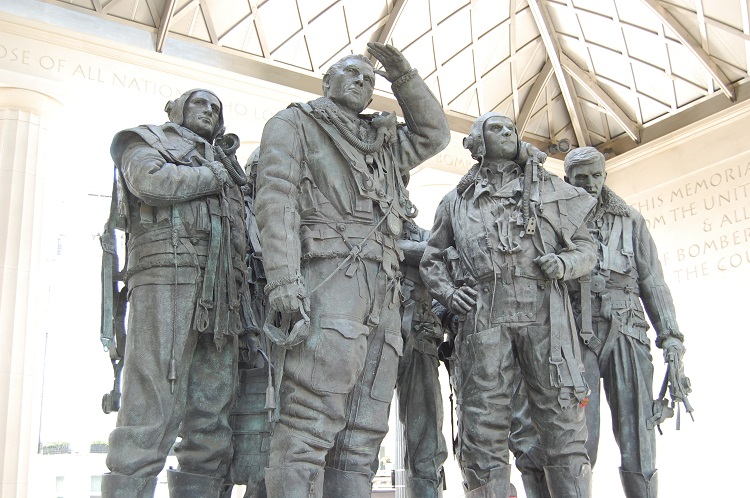
There is an on-line registry of commonwealth dead which contains information on the grave site of George Henry Scott as well as some personal information including the line that he is the "son of John and Joan Scott, of Montreal, Province of Quebec, Canada"
The Department of Veterans Affairs in Ottawa maintains a web site maintains a virtual memorial to those Canadians killed in the wars. The page for George Henry Scott contains the photo which is used above and which I have since learned was donated by Howard Scotter of England (of whom more below). In addition a researcher, Margaret Rose, who has been adding photos of RCAF members killed in WWII from their personel files in the National Archives of Canada.
St. Clement's Danes
The Gransden Church Memorial
The Last Mission
On the night of 27/8 January 1944 the 6th (RCAF) Bomber Group staged a mission to bomb Berlin. Included in this mission were Avro Lancaster II bombers from 408 (RCAF) Squadron, initially a squadron from Montreal, known as the Goose Squadron for its crest. In 1943-4 the squadron was based at Linton-on-Ouse about 15 km NW of the city of York in England. The bombers in this squadron had the squadron identification "EQ". Lancaster DS 849, the aircraft in which George flew his last mission, was designated as EQ-X. The photograph below, taken a few months later, shows EQ-Z, a similar aircraft of the squadron.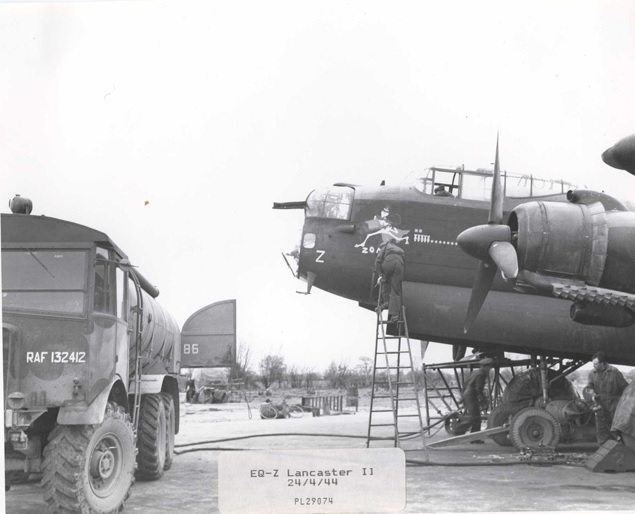
The Crew of DS 849 on its last mission
| Name |
Position |
Unit |
Home Town |
Age |
| F/L Sven Laine, D.F.C. |
Pilot |
RCAF |
||
For this mission George was an air gunner on EQ-X which was captained by Flight Lieutenant Sven Laine, D.F.C. While this was an RCAF squadron, the crew contained not only Canadians but also RAF and RNZAF members. The aircraft took off from the base at Linton-on-Ouse about 5:45 pm on January 27th. The aircraft was loaded with 1 x 4,000 lb. HC, 2 x 150 x 4 Incendiary, 8000 rounds S.A.A. (presumably one 4,000 lb bomb, 800 incendiary bombs and 8,000 rounds of ammunition for the machine guns). On the approach to the target and on return the aircraft would be flying at about 20,000 feet (4 miles) altitude. The aircraft was not heated or pressurized and the external temperatures would be about -30 degrees. To endure these conditions the crew wore heavy and insulated clothing and donned oxygen masks above about 10,000 feet.
At this time of year, in that part of England, this was a night take-off. The aircraft joined other aircraft of 408 Squadron and these squadron aircraft would join up with other squadrons of the 6th (RCAF) Bomber Group to form the attacking formation. The general destination of the attack was Berlin. Berlin had been repeatedly attacked since 1940 on a sporadic basis, but this attack occurred during what is considered the Battle of Berlin which lasted from 18 November 1943 to 30 March 1944.
Flight Operations Plan Night of 27-8 January 1944
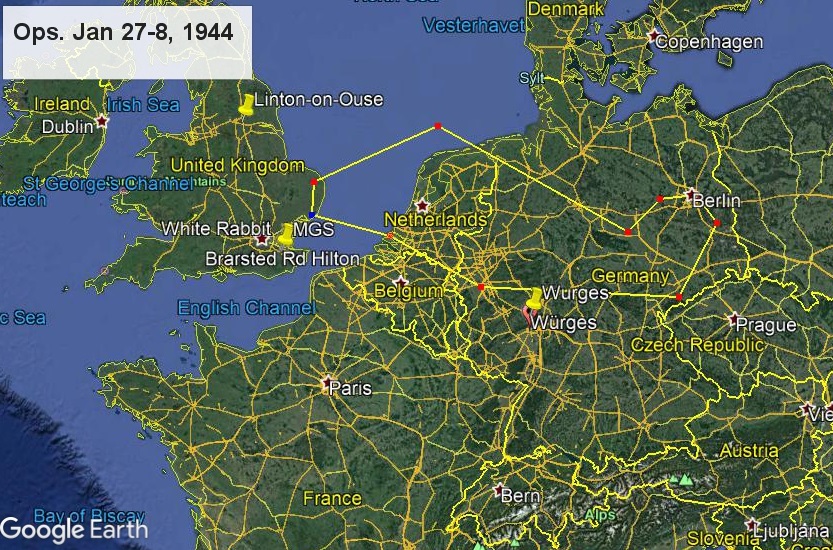 |
|
| A copy of the the planned flight
paths for the operations of the 6th RCAF Bomb
Group for the night of 27-8 January 1944 |
An approximate trace of the
projected route of the main attacking force for
the attack on Berlin, on a Google Earth image. The
return trip, after turning south from Berlin the
headed due west, more or less over the town of
Wurges where DS 879 was shot down. |
While the formation might have had some fighter cover for the first hour or so of the trip, such cover was restricted by the range and endurance of the fighter aircraft available at that time. Generally, these formations were subjected to flack (anti-aircraft artillery) on the approach paths and over the targets and also to night fighter attacks by the German airforce (Luftwaffe) when not in flack zones. While in formation little evasive action could be taken when subjected to either form of attack for fear of colliding with other aircraft in the formation. The air gunners in the aircraft (there were three sets of machine guns in each aircraft) were located in the dorsal turret,the tail sand the nose. We do not know which position (dorsal or tail) was occupied by George. The machine guns were located in the nose and manned by the bomb aimer.
DS 849 was expected to return to base about 1:30 a.m. in the morning of 28 January. It did not return and no further information was available on what happened to it from other aircraft in the squadron.
DS 849 Aircraft Missing
When their aircraft did not return it started an administrative process which would continue until after the end of the war. Firstly, on 28 January, having determined that the aircraft had not landed somewhere else in England, the status of the crew as missing was advised by telegram to Canadian Headquarters in Ottawa with direction to notify next of kin. Two days later on 30 January the squadron commander, Wing Commander D.S. Jacobs, D.F.C. sent a letter to each of the next of kin of the crew.
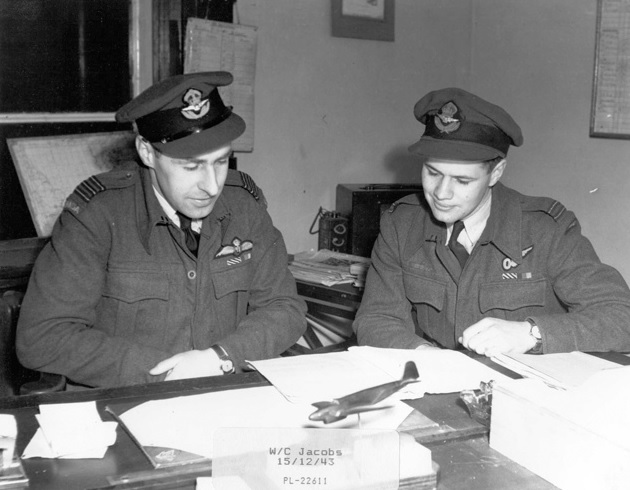 Wing Commander D.S. Jacobs, who
signed the above letter, is seated on the left in
this (staged) photograph taken in December 1943.
The unknown officer on the right is a Flight
Lieutenant and is wearing the "observer" wing of a
navigator. Both officers have the Distinguished
Flying Cross (DFC) ribbon, which if not awarded
for a particular mission was often awarded for
successfully completing a tour -- at that time
surviving 25 missions. Both officers are wearing
battle dress tunics.
|
|
At some point before the beginning of April word was received through the International Red Cross Commision (IRCC) that an aircraft had crashed, killing all aboard, and that it contained five named crew members of George's crew and 3 unnamed persons. George was not among those named.
Interestingly this is not the last item related to George during this period. On his personal R.C.A.F. file is a letter and response at the beginning of April of that year. It references a letter from the squadron advising that he is missing and asking for an address for his mother.
The letter is interesting in a few ways:
- someone on the squadron communicated George's missing
status to her. Was this a friend of George who knew her?
- But, if so, she would presumably have known the
address for George's mother
- was this a girlfriend of George's?
[note, on the Canadian Virtual War Memorial page for George Henry, the following (hidden) statement appears as a comment on the photograph we have above: "Photo of George Henry Scott - George visited my wife's grandmother (Mrs Kester)when he was in London.(Greyhound road, Hammersmith.) He may have stayed there ?. My wife's mother had the picture and the poem in a frame." This page was last updated on 3 March 2015]
Miss Kester received a response from the Air Ministry,
but, however, it was not particularly informative:
This response did not, in particular, provide Miss Kester
with contact information for George's mother. This lack of
information in the response was in general accord
with official policy at that time and probably now;
notification information was only made to the next-of-kin
and it was through them that others would learn. One
wonders if Miss Kester ever did make contact with George's
mother.
After the war the records of the German government were available to the Allies. Included in these was a record of the death of George.
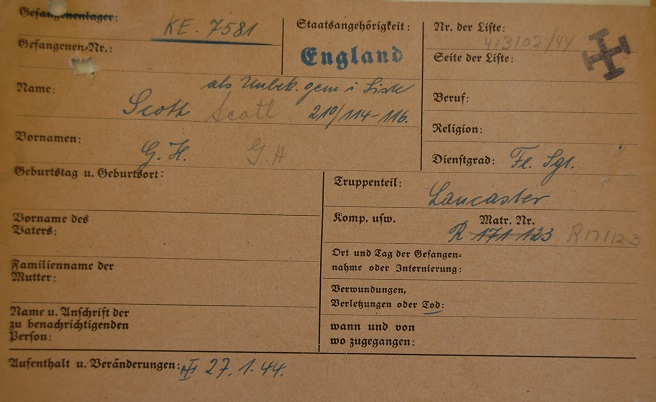
Burial
After the end of the war allied forces sought to determine the final resting places of aircrew that had disappeared during operations. The fate of DS 849 was part of this quest. There are numerous items on George's RCAF file related to the disposition of his remains. In summary they indicate that the aircraft crashed near the town of Wurges about 14 miles north of Wiesbaden in Germany. There were eight persons in the crashed aircraft and they were buried in a common grave in the local graveyard with a cross over the grave stating "8 Kanadische Flieger" (8 Canadian airmen). The bodies were stripped of their outer garments (the heavy garments would have been valuable in January at that time of the war in Germany). In accordance with agreed policy between the Commonwealth nations, the bodies were exhumed, identified where possible, and then buried in a British (later Commonwealth) War Grave. In the instance of this crew only one body was identifiable and the remaining crew members were buried in a common grave. All eight crew members are buried in two adjacent graves in Hanover, Germany.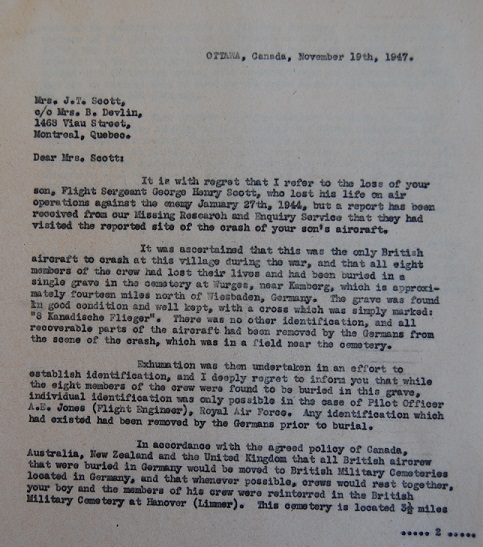 |
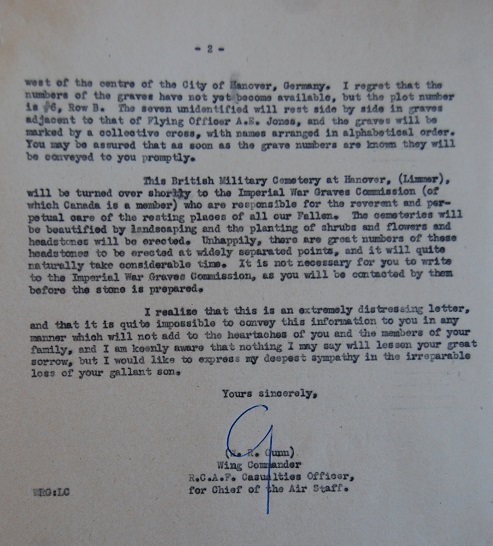 |
It is not known if any family members have ever visited these graves and I plan to do so later this year (1915)
Birth, Childhood and Civilian Career
Born April 4, 1921 in Saskatoon Saskatchewan the third child of John Thomas Scott and his wife Joan, nee Phillips. He was their third child, being preceded by his older sisters Margaret (b. 1916) and Jeanette (b. 1918).
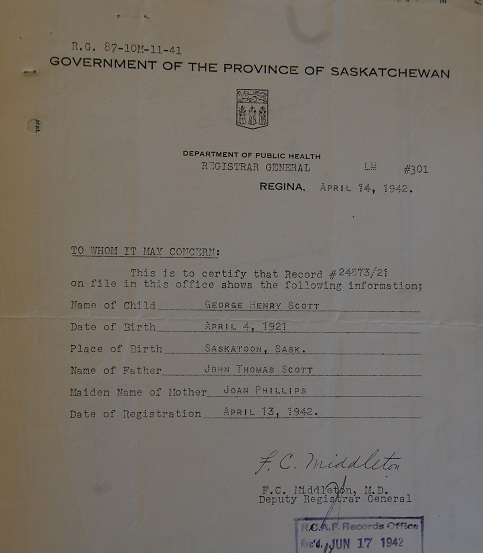
From his attestation papers we gain an outline of his education. He attended Maisonneuve School in Montreal from 1927 until 1934, completing the 7th grade. He then had one year of high school at the Commercial High School. At that point he took employment with Anderson Smythe Co. of Montreal as a clerk. However he continued his education at night school for a couple of years taking business and commercial courses. After three years in clerical positions, in 1938 he obtained a job with Canadian Vickers as an aircraft mechanic, a job he held until he joined the RCAF in 1942. The only other information we have is that he played hockey and soccer extensively. The impression he gives is of an active, healthy well rounded person.
The R.C.A.F. Years
George joined the R.C.A.F. on March 17, 1942. As an aircraft technician at Vickers he would have been in a 'protected' trade and presumably not subject to conscription. As a volunteer he was awarded (posthumously, the Canadian Volunteer Service Medal. It would be interesting to know what would have caused him to volunteer in 1942 at the age of 21 when he might have volunteered earlier or not at all.He initially asked to be considered for aircrew as a pilot or observer, however, due to his background at Vickers it was recommended that he be given a ground position as an aircraft engine mechanic (A.E.M.). He seems to have persevered in his desire for aircrew employment (the promotions, status among civilians and pay were better!) and was eventually selected to be an air gunner (A.G.) We have a couple of photographs taken about the time of his enlistment, probably shortly after he received his uniform as it bears no rank insignia.
 |
 |
| Buster as a new recruit. Probably
taken at the same time as the photo shown above,
probably in April or May 1942 |
Buster with his sisters Jeanette on
the left and Margaret on the right, likely taken at
the same time as the photo on the left. At the time
Buster was 21, Jeanette 24 and Margaret 26. |
His training in the R.C.A.F., in Canada, is itemized in the following extracts from his records. He went through basic training and then various other courses in Quebec and at R.C.A.F. Stn. Rockcliffe in Ottawa (where the author started his career as a commissioned office in the R.C.A.F. 20 years later in 1963)
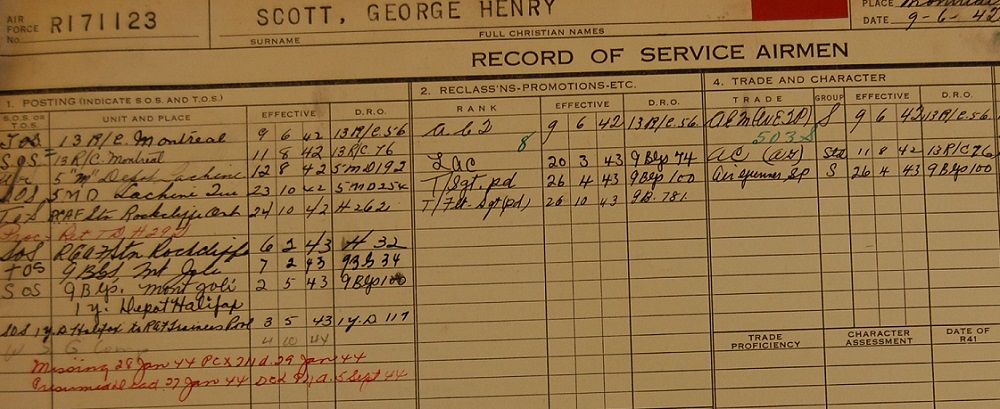
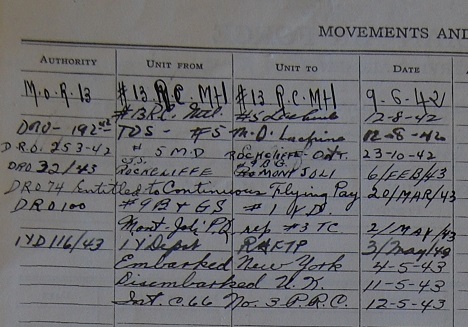
These documents shows that he received his qualification as an Air Gunner on 26 April 1943, that he completed air gunnery school and was promoted to Sgt (pd) and (importantly) entitled to continuous flying pay from 20 March 1943. They also show that he was soon on his way to England embarking from New York on the fourth of May 1943 and arriving in the U.K. on 11 May 1943. The following photograph was taken prior to his departure and after his promotion to Sgt. so about April 1943 and possibly at a going away get together
 |
|
| Sisters Jeanette on the left with
Margaret on the right. George is wearing his
sergeant's stripes and his air gunner wings. He
appears to have matured quite a bit since his
recruitment photo and the mood seems to be somber.
The glasses on the table make me think of a
Sergeant's mess or Legion Hall of the time. |
Buster's Air Gunner wings of the RCAF
which he wore on his uniform as shown in the photo
on the left. |
From here a new record of his active service (form 1580) tracks his experience.
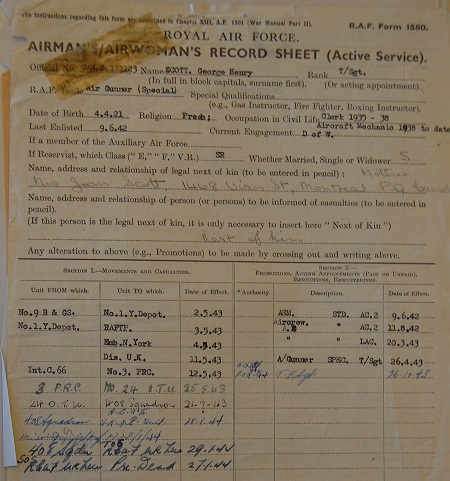
In the U.K. he is sent to the No. 3. PRC (a 'Manning' depot) for onward assignment. After spending 13 days there he is sent o No. 24 Operational Training Unit (O.T.U.) on the 25th of May. He spends almost two months there taking additional training as an air gunner before being sent to 408 (RCAF) Squadron on the 21st of July 1943. There are no further entries on his file until the disappearance of DS 849 on 28th January 1944. From the letter to his mother after he is reported missing we learn that he had completed 14 missions during this time period, an average of just over two per month.
Medals
George, through his service was eligible for a number of medals. These were issued after the war and by this time the RCAF was using IBM punch cards to record the eligibility and awarding of the medals. The following punch card shows his awards which are for the 1939-45 star, the aircrew Europe star, the Canadian Volunteer Service medal with bar (for service in the face of the enemy) and the War medal. An additional bar, the Bomber Command bar, which only became available recently, could also be claimed by a family member who currently has the medals.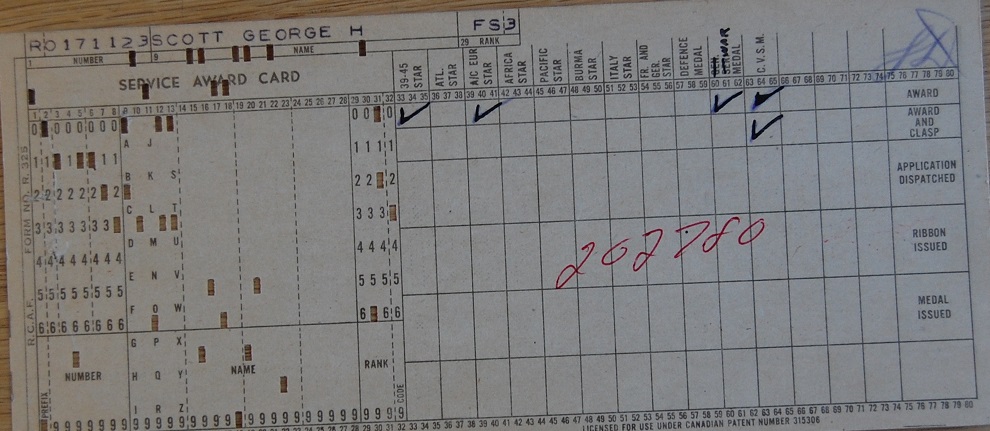
Buster's medals are currently in the possesion of his nephew Scott Taylor of Washington, D.C. They were never mounted, having been delivered to his mother Joan or foster mother, Barbara, a sister of Joan. They passed on to Buster's sister Margaret who left them to her son Scott. We are indebted to Scott for the following photos of the medals.
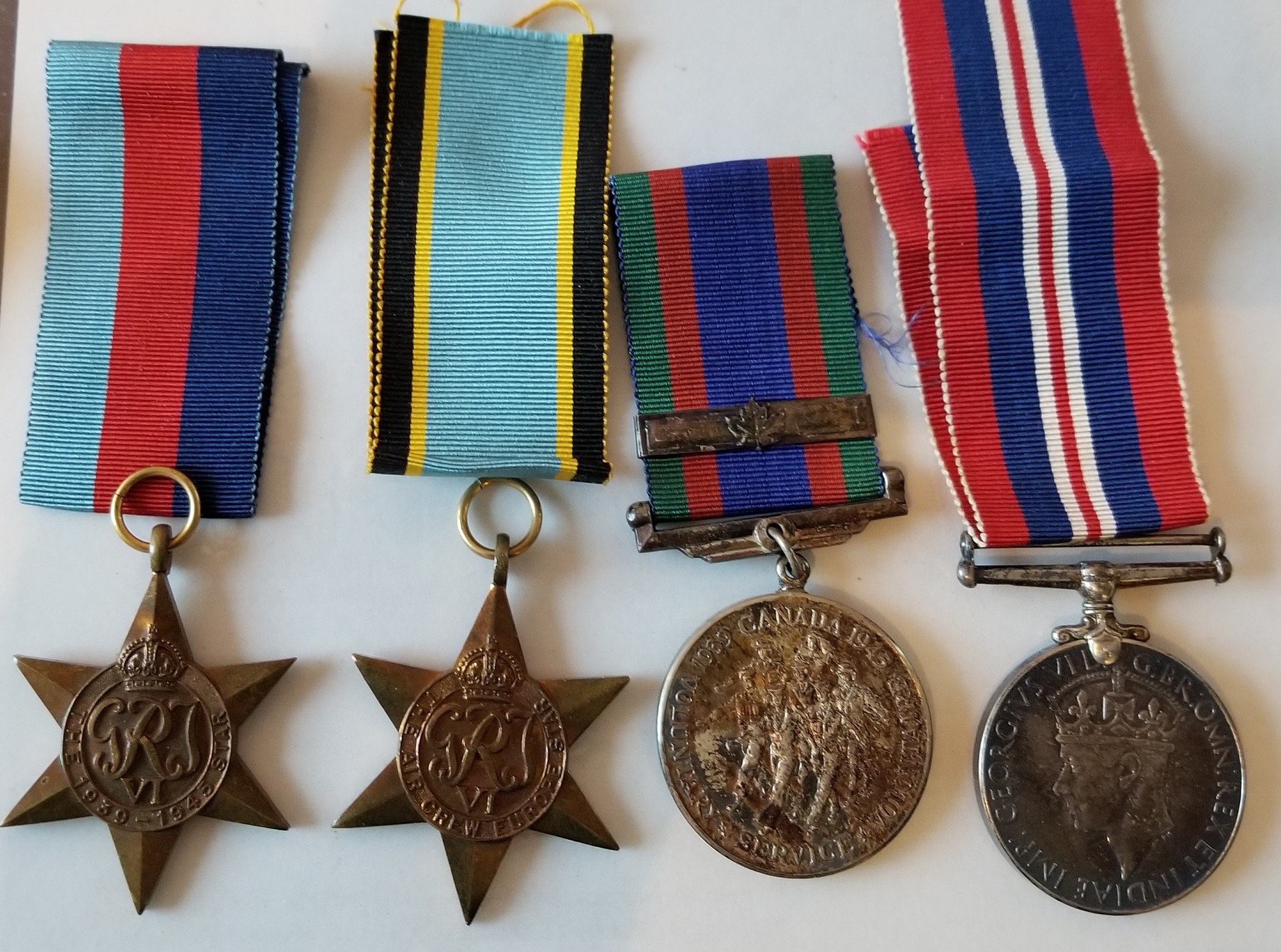 |
| Buster's medals: The 1939-1945 Star,
The Air Crew Europe Star (which is eligible for the
Bomber Command Clasp), The Volunteer Medal, with
clasp showing action in the face of the enemy, the
1939- 45 Victory Medal. They are shown in the order
that they would be worn. Buster never saw or wore
these medals and in Canada it is an offense for
anyone else to wear them (In other Commonwealth
countries they are often worn by family members at
remembrance services, in which case they are worn on
the right side, rather than the left.) |
Postscript () A visit to the Hanover Commonwealth War Cemetery, 2015/09/17
Postscript () A visit to Wurges 2015/09/23
Postscript () A visit to Howard Scotter and Family, Cambridgeshire
As noted above there was an interesting letter from a
Miss Kester inquiring into the fate of Buster and asking
for the address of his mother. I attempted to find some
information on Miss Kester. I checked birth registrations
and could not find any related to a Miss Kester giving
birth to any children in the 1944 time frame (It would
have been nice to find a child of Busters!). From there
the trail went cold. When I was doing this research in the
years indicated above, Miss Kester would have likely been
deceased if she were roughly the same age as Buster.
As also noted above a photograph of Buster, the first I
saw, was filed on the Virtual War Memorial at the Veterans
Department of the Canadian Government. I Eventually Howard
Scotter who posted that photograph contacted me by email
and made the following comments:
Margaret married, in the second quarter of 1953, Gerald W.E. Bysh. From this marriage there were two daughter,s, Anne b. 1954 and Gillian, b. 1959, who is Howard's wife. In addition to various emails back and forth I determined to visit Howard and his wife which I eventually did on 24 May 2016, about the time of their 30th wedding anniversary. The information that I received from them was very interesting and the photos and stories related here are from them, for which I give thanks.
As we saw above, Buster arrived in England on 11 May
1943. He went to Brighton to the aircrew "manning depot"
where all arriving aircrew were sent, to be assigned for
further training. he then was assigned to 408 Sqn, RCAF,
The "Goose Squadron" which, incidentally, was associated
with Montreal, the city he had grown up in.
During the period from his arrival in England to
the time of his death he would have had leave periods and
during this, presumably on visits to London, he met Miss
Kester.
Howard's wife was not close to her mother and it was only
upon the mother's death in 2008? that some of these
interesting facts came to light. Howard and his wife had
to close up the apartment. Beside her bed was a photograph
of Buster and a poem that was special to her (and perhaps
him)
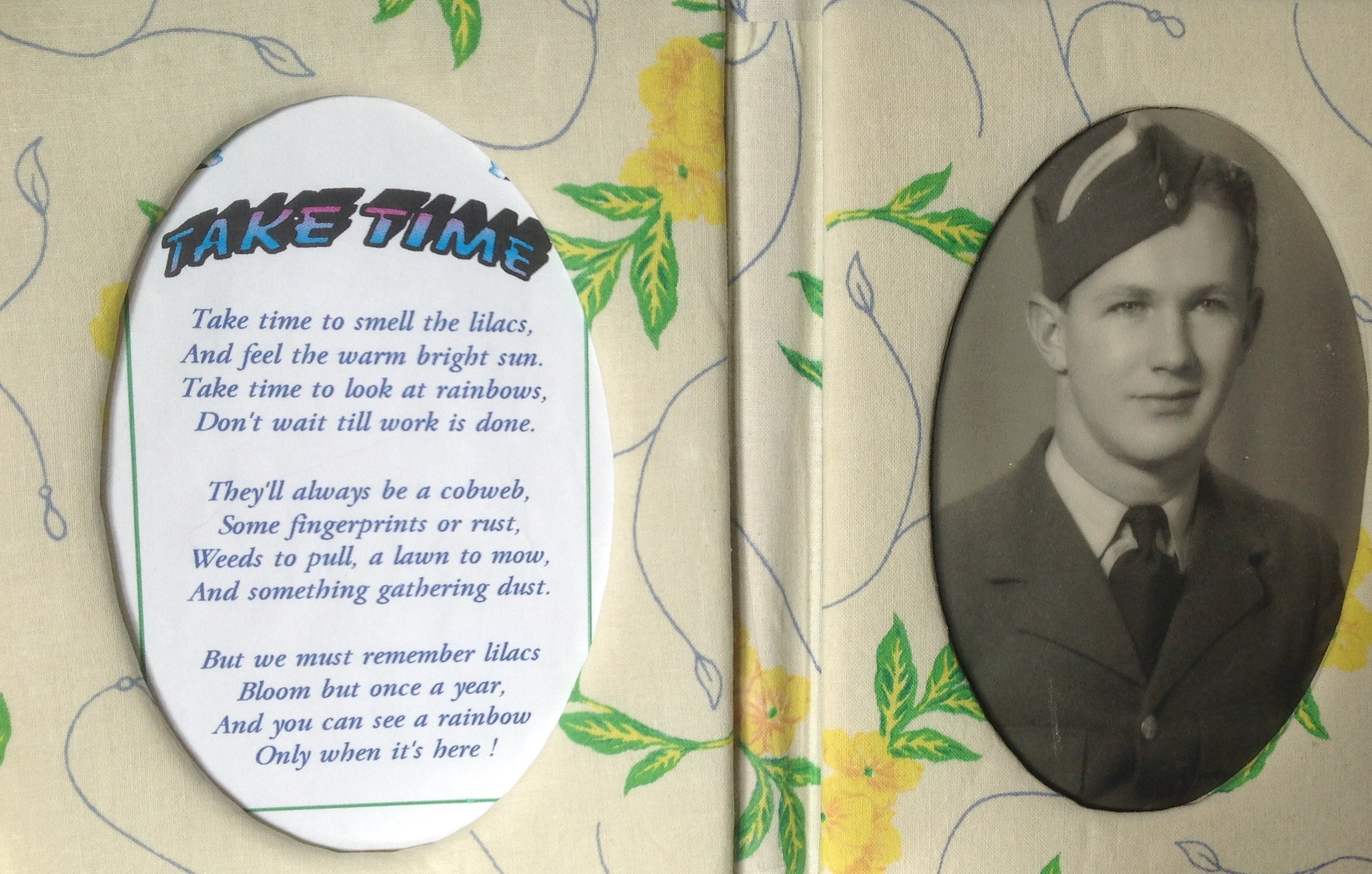 |
|
| The poem and photo of Buster found at
the bedside of Margaret after her death. |
It was finding the photo by the bed, and copies of the
letters shown above from Miss Kester,, that led Howard to
undertake research into the unknown Buster, to his posting
a photo on the Veteran's Affairs Virtual Memorial and
eventually to seeing my biography written in 2015.
Postscript () A visit to Linton-0n-Ouse, 2016/05/26
Postscript () A visit to Elaine Lazenby,
Postscript () A
visit from Scott Taylor, nephew of Buster, 2020/01/19
How exciting it was to receive an email on February 20, 2019 that read:
" I have just discovered your wonderful biography of my mother's brother, George Henry (Buster) Scott, the man I'm (sort of) named after.
Here was a connection to the part of the family that I had been seeking for almost a decade! The writer was (Eric) Scott Taylor. He has used the first name "Scott", in remembrance of "Buster", his uncle, all his life.
Of course, I responded immediately and that led to Scott visiting me, a year later in Florida (his daughter and grandchild live not too far away). When he came he brought the memorabilia he mentioned and we had a great few hours together. We communicate regularly.
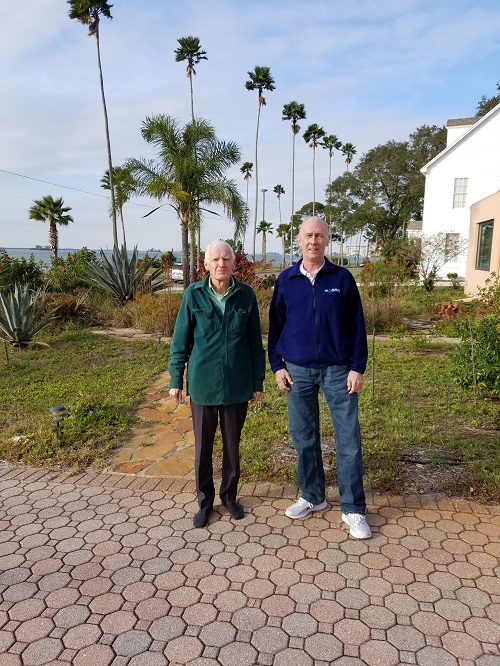 |
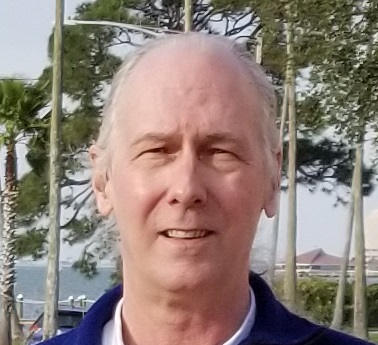 |
|
| A photograph of Scott Taylor and me
in front of my house in January 2020 |
Scott also wrote some information on his part of the family as he knows it, which information I have used to correct and expand parts of the original narrative.
References and Comments
- When DS 849 was lost, that aircraft was struck off strength of the squadron and another aircraft acquired and given the same identifier "EQ-X". EQ-X was not a lucky identifier. On the night of 24/25 February 1944 DS 844 bearing this same EQ-X identifier was lost over Schweinfurt, Germany. Altogether, during the war, at least 8 aircraft from 408 Squadron with this designation were lost [ search lostaircraft.com]
- George did not get selected as a pilot and I wondered
if his CT score of 37 or his lack of education might
been the cause. The Arnprior
Experiment in 1943 examined the question of pilot
selection and in a report on the experiment (a doctoral
thesis) the following statement was made: "The
applicant was temporarily accepted, subject to
findings of the medical examination, if he was between
17 1/2 and 33 years of age, if his CT score was 30 or
more, and if he satisfied the interviewer that he
sincerely desired to take up airccrew training and
would accept the aircrew trade to which he might be
assigned later by the Classification Board at the
Manning Depot. Lack of formal education was no bar to
enlistment but candidates who has not completed Grade
VIII were not accepted without relatively high CT
scores. . . the CT score limit of 30 was nevertheless
considerably below the score of 48 normally required
of pilot candidates".
Further Research and Comments
1. This is a work in progress. Yet, so
far, much has been accomplished and I felt it important to
acknowledge all those who have helped me as well as to
synthesize the information so far accumulated on this
search. Any additional contributions will be much
appreciated.
- Barbara (Phillips) Devlin, aunt, foster mother and
beneficiary of George Henry Scott. Barbara married John
Devlin. She died in 1972 and her ashes are at Westmount
Cemetery. In 1944 she lived at 1468 Viau St. in Monteal
- Margaret (Scott) MacDonell, (b. 1916) sister of George who lived at 2064 Mansfield St., Montreal in 1944
- Jeanette (Scott) Connell, (b. 1918) sister of George who lived at 1452 Theodore St., Montreal in 1944
This contact was first made in February 2019 when I was
contacted by Scott Taylor a nephew of Buster, and son of
Buster's sister Margaret. Much of the family information
as well as photographs of medals and the family has been
provided by him.
2. To obtain information on any additional monuments or
memorials that might include George's name. These might be
at schools he attended or perhaps at a Legion Hall or in
the City Hall in Montreal.
3. To make contact with cousins who are the descendants
of Jeanette (Scott) Connell
Acknowledgements
- The Commonwealth War Graves Commission site for details of his resting place and date of death.
- The Library and Archives Canada site for copies of his service papers.
- Veterans Affairs Canada for access to the Memorial Book Page Image
- Charlotte Edwards, a fellow genealogist who first
brought the 1916 and 1918 census entries in Saskatoon to
my attention
- Maureen Anderson of Saskatchewan, a fellow genealogist who has helped in many ways in researching family details in Saskatoon.
- David March of the Saskatoon Quilt Project who helped in particular with locating Lancaster DS 849 on the lostaircraft site.
- Jean Reed in England, a niece of George's who has helped particularly in researching the Phillips side of the family, but, who much earlier contacted me with information on her part of the Scott family.
- Claus on the lostaircraft site for his help in understanding the information therein.
- Barry Miller for suggestions and information related to using the facilities at the Library and Archives Canada in Ottawa.
- Howard Scotter for the information about Buster as it
relates to his mother-in-law who knew Buster during the
war: Howard also contributed the first photograph of
Buster that I received, and a number of other
photographs.
- Scott Taylor for contacting me and for sharing family information and photographs, particularly, not only of Buster but of his half-brother of the same name, known as Geo.
- Elaine Lazenby, author of "The Call of the Goose" a
biography of her uncle, XXXXX, and in particular a
record of the shooting down of EQ=X and source of
biographies of the crew members. Her sole source of
information on Buster derived from the records in the
National Archives of Canada, which, as mentioned above,
contain considerable amounts of wrong information as a
result of Buster's incorrect knowledge of his father.
©Kenneth Scott and others 2015, 2021
email: ken at kenscott.comfirst published 24 February 2015
revised 27 January 2021